Spatiotemporal Pattern of Vegetation Coverage and Its Response to LULC Changes in Coastal Regions in South China from 2000 to 2020
Abstract
:1. Introduction
2. Materials and Methods
2.1. Study Area
2.2. Research Framework and Data Processing
2.3. Spatiotemporal Characteristics Analysis
2.3.1. Classification of NDVI and LULC
2.3.2. Sankey Diagram for NDVI and LULC Change Matrix Visualization
2.3.3. Dynamic Degree of NDVI and LULC Change
2.4. Analysis Method for Response of Vegetation Coverage to LULC Change
2.4.1. Analysis Method for Response Distribution
2.4.2. Analysis Method for Contribution Rate Index
3. Results
3.1. Spatiotemporal Characteristics of NDVI
3.1.1. NDVI Spatiotemporal Distribution
3.1.2. NDVI Spatiotemporal Change
3.2. Spatiotemporal Characteristics of LULC
3.2.1. LULC Spatiotemporal Distribution
3.2.2. LULC Spatiotemporal Change
3.3. Response of Vegetation Coverage to LULC Change
3.3.1. Response Distribution of Vegetation Coverage to LULC Changes
3.3.2. Contribution Rate Index
4. Discussion
4.1. Changing Trends of NDVI and LULC
4.2. Response of NDVI Changes to LULC Changes
4.3. Limitations and Prospects
5. Conclusions
- (1)
- The overall vegetation coverage in the coastal regions of the Guangdong Province is relatively high, with higher coverage and above being the main categories (accounting for 85.37% to 89.48%) and high coverage mainly distributed in the east and west. From 2000 to 2020, the vegetation coverage in this region gradually increased overall, but decreased in the central region. There were spatiotemporal differences in the transfer of different vegetation coverage levels, and over time, the transfer became increasingly frequent;
- (2)
- The LULC structure mainly comprises forest land (46.5% to 47.5%) and cultivated land (30.7% to 33.4%), with forest land mainly distributed in relatively high-altitude regions and cultivated land mainly distributed in the plains. In terms of space, forest land and cultivated land remain dominant. In terms of time, the changes in LULC from 2015 to 2020 were relatively significant, especially the mutual transfer of cultivated land and forest land. The built-up land continued to increase from 2000 to 2020, but the speed gradually slowed down;
- (3)
- The change in vegetation coverage showed a trend of improvement on the whole, especially in the western and central mountainous and hilly regions, but in the central the Pearl River Delta there was a large regional deterioration. The NDVI change caused by the transfer of forest land to other land was the most significant. The net contribution rate of forest land change to vegetation coverage change had the largest range (−38.903% to 23.144%), but the average was the lowest (−6.179%).
Author Contributions
Funding
Institutional Review Board Statement
Informed Consent Statement
Data Availability Statement
Conflicts of Interest
References
- Chen, J.; Shao, Z.; Deng, X.; Huang, X.; Dang, C. Vegetation as the catalyst for water circulation on global terrestrial ecosystem. Sci. Total Environ. 2023, 895, 165071. [Google Scholar] [CrossRef] [PubMed]
- Ding, Y.; Feng, Y.; Chen, K.; Zhang, X. Analysis of spatial and temporal changes in vegetation cover and its drivers in the Aksu River Basin, China. Sci. Rep. 2024, 14, 10165. [Google Scholar] [CrossRef] [PubMed]
- Recuero, L.; Litago, J.; Pinzón, J.E.; Huesca, M.; Moyano, M.C.; Palacios-Orueta, A. Mapping periodic patterns of global vegetation based on spectral analysis of NDVI time series. Remote Sens. 2019, 11, 2497. [Google Scholar] [CrossRef]
- Fensholt, R.; Langanke, T.; Rasmussen, K.; Reenberg, A.; Prince, S.D.; Tucker, C.; Scholes, R.J.; Le, Q.B.; Bondeau, A.; Eastman, R.; et al. Greenness in semi-arid areas across the globe 1981–2007—An Earth Observing Satellite based analysis of trends and drivers. Remote Sens. Environ. 2012, 121, 144–158. [Google Scholar] [CrossRef]
- Jiang, F.; Deng, M.; Long, Y.; Sun, H. Spatial pattern and dynamic change of vegetation greenness from 2001 to 2020 in Tibet, China. Front. Plant Sci. 2022, 13, 892625. [Google Scholar] [CrossRef]
- Wang, X.; Liu, G.; Xiang, A.; Qureshi, S.; Li, T.; Song, D.; Zhang, C. Quantifying the human disturbance intensity of ecosystems and its natural and socioeconomic driving factors in urban agglomeration in South China. Environ. Sci. Pollut. Res. 2022, 29, 11493–11509. [Google Scholar] [CrossRef]
- Zhang, T.; Cheng, C.; Wu, X. Mapping the spatial heterogeneity of global land use and land cover from 2020 to 2100 at a 1 km resolution. Sci. Data 2023, 10, 748. [Google Scholar] [CrossRef]
- Yang, L.; Shi, L.; Li, J.; Kong, H. Spatio-temporal pattern change of LULC and its response to climate in the Loess Plateau, China. Sci. Rep. 2024, 14, 23202. [Google Scholar] [CrossRef]
- He, Q.; Silliman, B.R. Climate change, human impacts, and coastal ecosystems in the Anthropocene. Curr. Biol. 2019, 29, R1021–R1035. [Google Scholar] [CrossRef]
- Allan, H.; Levin, N.; Kark, S. Quantifying and mapping the human footprint across Earth’s coastal areas. Ocean Coast. Manag. 2023, 236, 106476. [Google Scholar] [CrossRef]
- Barragán, J.M.; De Andrés, M. Analysis and trends of the world’s coastal cities and agglomerations. Ocean Coast. Manag. 2015, 114, 11–20. [Google Scholar] [CrossRef]
- Day, J.W.; Gunn, J.D.; Burger, J.R. Diminishing opportunities for sustainability of coastal cities in the anthropocene: A review. Front. Environ. Sci. 2021, 9, 663275. [Google Scholar] [CrossRef]
- Wei, S.; Zhang, H.; Xu, Z.; Lin, G.; Lin, Y.; Liang, X.; Ling, J.; Wee, A.K.S.; Lin, H.; Zhou, Y.; et al. Coastal urbanization may indirectly positively impact growth of mangrove forests. Commun. Earth Environ. 2024, 5, 608. [Google Scholar] [CrossRef]
- Tapas, M.R.; Do, S.K.; Etheridge, R.; Lakshmi, V. Investigating the impacts of climate change on hydroclimatic extremes in the Tar-Pamlico River basin, North Carolina. J. Environ. Manag. 2024, 363, 121375. [Google Scholar] [CrossRef]
- Lakshmi, V.; Lakshmi, V. Enhancing human resilience against climate change: Assessment of hydroclimatic extremes and sea level rise impacts on the Eastern Shore of Virginia, United States. Sci. Total Environ. 2024, 947, 174289. [Google Scholar] [CrossRef]
- Tapas, M.R.; Etheridge, R.; Finlay, C.G.; Peralta, A.L.; Bell, N.; Xu, Y.; Lakshmi, V. A methodological framework for assessing sea level rise impacts on nitrate loading in coastal agricultural watersheds using SWAT+: A case study of the Tar-Pamlico River basin, North Carolina, USA. Sci. Total Environ. 2024, 951, 175523. [Google Scholar] [CrossRef]
- da Silva, V.S.; Salami, G.; da Silva, M.I.O.; Silva, E.A.; Monteiro Junior, J.J.; Alba, E. Methodological evaluation of vegetation indexes in land use and land cover (LULC) classification. Geol. Ecol. Landsc. 2020, 4, 159–169. [Google Scholar] [CrossRef]
- Liu, Y.; Wang, X.; Guo, M.; Tani, H.; Matsuoka, N.; Matsumura, S. Spatial and temporal relationships among NDVI, climate factors, and land cover changes in Northeast Asia from 1982 to 2009. GISci. Remote Sens. 2011, 48, 371–393. [Google Scholar] [CrossRef]
- Li, P.; Wang, J.; Liu, M.; Xue, Z.; Bagherzadeh, A.; Liu, M. Spatio-temporal variation characteristics of NDVI and its response to climate on the Loess Plateau from 1985 to 2015. Catena 2021, 203, 105331. [Google Scholar] [CrossRef]
- Qu, S.; Wang, L.; Lin, A.; Yu, D.; Yuan, M. Distinguishing the impacts of climate change and anthropogenic factors on vegetation dynamics in the Yangtze River Basin, China. Ecol. Indic. 2020, 108, 105724. [Google Scholar] [CrossRef]
- Camps-Valls, G.; Campos-Taberner, M.; Moreno-Martínez, Á.; Walther, S.; Duveiller, G.; Cescatti, A.; Mahecha, M.D.; Muñoz-Marí, J.; García-Haro, F.J.; Guanter, L.; et al. A unified vegetation index for quantifying the terrestrial biosphere. Sci. Adv. 2021, 7, eabc7447. [Google Scholar] [CrossRef] [PubMed]
- Jacquin, A.; Sheeren, D.; Lacombe, J.P. Vegetation cover degradation assessment in Madagascar savanna based on trend analysis of MODIS NDVI time series. Int. J. Appl. Earth Obs. Geoinf. 2010, 12, S3–S10. [Google Scholar] [CrossRef]
- Jin, H.; Chen, X.; Wang, Y.; Zhong, R.; Zhao, T.; Liu, Z.; Tu, X. Spatio-temporal distribution of NDVI and its influencing factors in China. J. Hydrol. 2021, 603, 127129. [Google Scholar] [CrossRef]
- Hosen, M.K.; Alam, M.S.; Chakraborty, T.; Golder, M.R. Monitoring spatiotemporal and seasonal variation of agricultural drought in Bangladesh using MODIS-derived vegetation health index. J. Earth Syst. Sci. 2023, 132, 188. [Google Scholar] [CrossRef]
- Li, S.; Xu, L.; Jing, Y.; Yin, H.; Li, X.; Guan, X. High-quality vegetation index product generation: A review of NDVI time series reconstruction techniques. Int. J. Appl. Earth Obs. Geoinf. 2021, 105, 102640. [Google Scholar] [CrossRef]
- Huang, S.; Tang, L.; Hupy, J.P.; Wang, Y.; Shao, G. A commentary review on the use of normalized difference vegetation index (NDVI) in the era of popular remote sensing. J. For. Res. 2021, 32, 1–6. [Google Scholar] [CrossRef]
- Xu, Y.; Yang, Y.; Chen, X.; Liu, Y. Bibliometric analysis of global NDVI research trends from 1985 to 2021. Remote Sens. 2022, 14, 3967. [Google Scholar] [CrossRef]
- Chen, Y.; Ma, L.; Liu, T.; Huang, X.; Sun, G. The Synergistic Effect between Precipitation and Temperature for the NDVI in Northern China from 2000 to 2018. Appl. Sci. 2023, 13, 8425. [Google Scholar] [CrossRef]
- Li, X.; Wang, Y.; Zhao, Y.; Zhai, J.; Liu, Y.; Han, S.; Liu, K. Research on the Impact of Climate Change and Human Activities on the NDVI of Arid Areas—A Case Study of the Shiyang River Basin. Land 2024, 13, 533. [Google Scholar] [CrossRef]
- Li, J. Responses of Vegetation NDVI to Climate Change and Land Use in Ordos City, North China. Appl. Sci. 2022, 12, 7288. [Google Scholar] [CrossRef]
- Chai, H.; Guan, P.; Hu, J.; Geng, S.; Ding, Y.; Xu, H.; Zhao, Y.; Xu, M. Temporal and Spatial Variations in the Normalized Difference Vegetation Index in Shanxi Section of the Yellow River Basin and Coal Mines and Their Response to Climatic Factors. Appl. Sci. 2023, 13, 12596. [Google Scholar] [CrossRef]
- Huang, Y.; Jin, Y.; Chen, S. The Spatiotemporal Dynamics of Vegetation Cover and Its Response to the Grain for Green Project in the Loess Plateau of China. Forests 2024, 15, 1949. [Google Scholar] [CrossRef]
- Qiao, X.; Zhang, J.; Liu, L.; Zhang, J.; Zhao, T. Spatiotemporal Changes in Vegetation Cover during the Growing Season and Its Implications for Chinese Grain for Green Program in the Luo River Basin. Forests 2024, 15, 1649. [Google Scholar] [CrossRef]
- Li, Y.; Sun, J.; Wang, M.; Guo, J.; Wei, X.; Shukla, M.K.; Qi, Y. Spatiotemporal variation of fractional vegetation cover and its response to climate change and topography characteristics in Shaanxi Province, China. Appl. Sci. 2023, 13, 11532. [Google Scholar] [CrossRef]
- Liu, S.; Gu, Y.; Wang, H.; Lin, J.; Zhuo, P.; Ao, T. Response of Vegetation Coverage to Climate Drivers in the Min-Jiang River Basin along the Eastern Margin of the Tibetan Plat-Eau, 2000–2022. Forests 2024, 15, 1093. [Google Scholar] [CrossRef]
- Qi, G.; Cong, N.; Luo, M.; Qiu, T.; Rong, L.; Ren, P.; Xiao, J. Contribution of Climatic Change and Human Activities to Vegetation Dynamics over Southwest China during 2000–2020. Remote Sens. 2024, 16, 3361. [Google Scholar] [CrossRef]
- Jin, K.; Jin, Y.; Li, C.; Li, L. Spatial and Temporal Dynamics in Vegetation Greenness and Its Response to Climate Change in the Tarim River Basin, China. ISPRS Int. J. Geo-Inf. 2024, 13, 304. [Google Scholar] [CrossRef]
- Han, Q.; Xue, L.; Qi, T.; Liu, Y.; Yang, M.; Chu, X.; Liu, S. Dynamic Spatiotemporal Evolution and Driving Mechanisms of Vegetation in the Lower Reaches of the Tarim River, China. Water 2024, 16, 2157. [Google Scholar] [CrossRef]
- Dong, D.; Zhao, Z.; Gao, H.; Zhou, Y.; Gong, D.; Du, H.; Fujioka, Y. Analysis of Spatiotemporal Evolution and Driving Forces of Vegetation from 2001 to 2020: A Case Study of Shandong Province, China. Forests 2024, 15, 1245. [Google Scholar] [CrossRef]
- Chen, P.; Pan, H.; Xu, Y.; He, W.; Yao, H. Spatial-Temporal Evolution Characteristics and Driving Force Analysis of NDVI in Hubei Province, China, from 2000 to 2022. Forests 2024, 15, 719. [Google Scholar] [CrossRef]
- Zhang, D.; Yi, M.; Sun, Z.; Wang, Y.; Sui, K. Changes in Vegetation Greenness and Responses to Land Use Changes in the Yongding River Basin (in North China) from 2002 to 2022. Agronomy 2024, 14, 2292. [Google Scholar] [CrossRef]
- Huang, Y.; Li, X.; Liu, D.; Duan, B.; Huang, X.; Chen, S. Evaluation of vegetation restoration effectiveness along the Yangtze River shoreline and its response to land use changes. Sci. Rep. 2024, 14, 7611. [Google Scholar] [CrossRef] [PubMed]
- Sun, W.; Song, X.; Mu, X.; Gao, P.; Wang, F.; Zhao, G. Spatiotemporal vegetation cover variations associated with climate change and ecological restoration in the Loess Plateau. Agric. For. Meteorol. 2015, 209, 87–99. [Google Scholar] [CrossRef]
- Jiang, L.; Bao, A.; Guo, H.; Ndayisaba, F. Vegetation dynamics and responses to climate change and human activities in Central Asia. Sci. Total Environ. 2017, 599, 967–980. [Google Scholar] [CrossRef]
- Liu, G.; Xiang, A.; Wan, Z.; Lv, H.; Liu, H.; Hu, Z.; Chen, L. Phenological changes of woody plants in the southern and northern regions of Nanling Mountains and their relationship with climatic factors. Forests 2023, 14, 2363. [Google Scholar] [CrossRef]
- Yu, S.; Du, W.; Zhang, X.; Hong, Y.; Liu, Y.; Hong, M.; Chen, S. Spatiotemporal changes in NDVI and its driving factors in the Kherlen River Basin. Chin. Geogr. Sci. 2023, 33, 377–392. [Google Scholar] [CrossRef]
- Liu, H.; Zheng, L.; Yin, S. Multi-perspective analysis of vegetation cover changes and driving factors of long time series based on climate and terrain data in Hanjiang River Basin, China. Arab. J. Geosci. 2018, 11, 509. [Google Scholar] [CrossRef]
- Do, S.K.; Nguyen, B.Q.; Tran, V.N.; Grodzka-Łukaszewska, M.; Sinicyn, G.; Lakshmi, V. Investigating the Future Flood and Drought Shifts in the Transboundary Srepok River Basin Using CMIP6 Projections. IEEE J. Sel. Top. Appl. Earth Obs. Remote Sens. 2024, 17, 7516–7529. [Google Scholar] [CrossRef]
- Sun, W.; Shao, Q.; Liu, J. Soil erosion and its response to the changes of precipitation and vegetation cover on the Loess Plateau. J. Geogr. Sci. 2013, 23, 1091–1106. [Google Scholar] [CrossRef]
- Fokeng, R.M.; Fogwe, Z.N. Landsat NDVI-based vegetation degradation dynamics and its response to rainfall variability and anthropogenic stressors in Southern Bui Plateau, Cameroon. Geosyst. Geoenviron. 2022, 1, 100075. [Google Scholar] [CrossRef]
- Deng, S.F.; Yang, T.B.; Zeng, B.; Zhu, X.F.; Xu, H.J. Vegetation cover variation in the Qilian Mountains and its response to climate change in 2000–2011. J. Mt. Sci. 2013, 10, 1050–1062. [Google Scholar] [CrossRef]
- Le, M.H.; Zhang, R.; Nguyen, B.Q.; Bolten, J.D.; Lakshmi, V. Robustness of gridded precipitation products for Vietnam basins using the comprehensive assessment framework of rainfall. Atmos. Res. 2023, 293, 106923. [Google Scholar] [CrossRef]
- Tran, T.N.D.; Nguyen, B.Q.; Grodzka-Łukaszewska, M.; Sinicyn, G.; Lakshmi, V. The role of reservoirs under the impacts of climate change on the Srepok River basin, Central Highlands of Vietnam. Front. Environ. Sci. 2023, 11, 1304845. [Google Scholar] [CrossRef]
- Nguyen, B.Q.; Vo, N.D.; Le, M.H.; Nguyen, Q.D.; Lakshmi, V.; Bolten, J.D. Quantification of global Digital Elevation Model (DEM)–A case study of the newly released NASADEM for a river basin in Central Vietnam. J. Hydrol. Reg. Stud. 2023, 45, 101282. [Google Scholar] [CrossRef]
- Nguyen, B.Q.; Van Binh, D.; Tran, T.N.D.; Kantoush, S.A.; Sumi, T. Response of streamflow and sediment variability to cascade dam development and climate change in the Sai Gon Dong Nai River basin. Clim. Dyn. 2024, 62, 7997–8017. [Google Scholar] [CrossRef]
- Zhao, L.; Wang, P.; Ouyang, X.; Wu, Z. An analysis of the spatio-temporal variation in fractional vegetation cover and its relationship with non-climate factors in Nanchang City, China. Acta Ecol. Sin. 2016, 36, 3723–3733. (In Chinese) [Google Scholar]
- Wang, S.; Zhang, L.; Lin, W.; Huang, Q.; Song, Y.; Ye, M. Study on vegetation coverage land-use change of Guangdong Province based on MODIS-NDVI. Acta Ecol. Sin. 2022, 42, 2149–2163. (In Chinese) [Google Scholar] [CrossRef]
- Bhimala, K.R.; Rakesh, V.; Prasad, K.R.; Mohapatra, G.N. Identification of vegetation responses to soil moisture, rainfall, and LULC over different meteorological subdivisions in India using remote sensing data. Theor. Appl. Climatol. 2020, 142, 987–1001. [Google Scholar] [CrossRef]
- Nguyen, B.Q.; Tran, T.N.D.; Grodzka-Łukaszewska, M.; Sinicyn, G.; Lakshmi, V. Assessment of urbanization-induced land-use change and its impact on temperature, evaporation, and humidity in central Vietnam. Water 2022, 14, 3367. [Google Scholar] [CrossRef]
- Machiwa, H.; Tian, B.; Sengupta, D.; Chen, Q.; Meadows, M.; Zhou, Y. Vegetation dynamics in response to human and climatic factors in the Tanzanian Coast. Front. Earth Sci. 2021, 15, 595–605. [Google Scholar] [CrossRef]
- Wang, X.; Zhong, W.; Li, T.; Quan, M.; Wang, B.; Wei, Z. A 16.2-kyr lacustrine sediment record of mercury deposition in Dahu Swamp, eastern Nanling Mountains, southern China: Analysis of implications for climatic changes. Quat. Int. 2021, 592, 12–21. [Google Scholar] [CrossRef]
- Wang, X.; Zhong, W.; Quan, M.; Li, T.; Lin, D.; Zhang, C. Asynchronous variations of mercury accumulation since the last deglaciation in the eastern and western Nanling mountains in South China. Quat. Sci. Rev. 2024, 325, 108490. [Google Scholar] [CrossRef]
- Wang, X.; Zhong, W.; Wang, B.; Quan, M.; Li, T.; Lin, D.; Shang, S.; Zhu, C.; Zhang, C.; Liao, Y. Spatial–temporal variations and pollution risks of mercury in water and sediments of urban lakes in Guangzhou City, South China. Environ. Sci. Pollut. Res. 2022, 29, 80817–80830. [Google Scholar] [CrossRef]
- Wang, X.; Liu, G.; Zhang, C.; Liao, Y. Spatial-temporal pattern and urban-rural gradient of comprehensive ecological security in urban agglomeration in South China from 2000 to 2020. Environ. Sci. Pollut. Res. 2023, 30, 102474–102489. [Google Scholar] [CrossRef]
- Xu, X. China Annual Normalized Difference Vegetation Index (NDVI) Spatial Distribution Dataset. Data Regist. Publ. Syst. Resour. Environ. Sci. Data Cent. Chin. Acad. Sci. 2018. (In Chinese) [Google Scholar] [CrossRef]
- Jiang, L.; Liu, Y.; Wu, S.; Yang, C. Analyzing ecological environment change and associated driving factors in China based on NDVI time series data. Ecol. Indic. 2021, 129, 107933. [Google Scholar] [CrossRef]
- Xu, X.; Liu, J.; Zhang, S.; Li, R.; Yan, C.; Wu, S. China multi period land use/land cover remote sensing monitoring dataset (CNLUCC). Data Regist. Publ. Syst. Resour. Environ. Sci. Data Cent. Chin. Acad. Sci. 2018. (In Chinese) [Google Scholar] [CrossRef]
- Li, S.; Su, S.; Liu, Y.; Zhou, X.; Luo, Q.; Paudel, B. Effectiveness of the Qilian Mountain nature reserve of China in reducing human impacts. Land 2022, 11, 1071. [Google Scholar] [CrossRef]
- Wang, X.; Liu, G.; Lin, D.; Lin, Y.; Lu, Y.; Xiang, A.; Xiao, S. Water yield service influence by climate and land use change based on InVEST model in the monsoon hilly watershed in South China. Geomat. Nat. Hazards Risk 2022, 13, 2024–2048. [Google Scholar] [CrossRef]
- Liu, G.; Xiang, A.; Huang, Y.; Zha, W.; Chen, Y.; Mao, B. Landscape changes and optimization in an ecological red line area: A case study in the Upper Reaches of the Ganjiang River. Int. J. Environ. Res. Public Health 2022, 19, 11530. [Google Scholar] [CrossRef]
- Wang, X.; Liu, G.; Xiang, A.; Xiao, S.; Lin, D.; Lin, Y.; Lu, Y. Terrain gradient response of landscape ecological environment to land use and land cover change in the hilly watershed in South China. Ecol. Indic. 2023, 146, 109797. [Google Scholar] [CrossRef]
- Liu, G.; Wang, X.; Xiang, A.; Wang, X.; Wang, B.; Xiao, S. Spatial heterogeneity and driving factors of land use change in the middle and upper reaches of Ganjiang River, southern China. Chin. J. Appl. Ecol. 2021, 32, 2545–2554. (In Chinese) [Google Scholar] [CrossRef]
- Yousafzai, S.; Saeed, R.; Rahman, G.; Farish, S. Spatio-temporal assessment of land use dynamics and urbanization: Linking with environmental aspects and DPSIR framework approach. Environ. Sci. Pollut. Res. 2022, 29, 81337–81350. [Google Scholar] [CrossRef] [PubMed]
- Yang, X.; Wang, J.; Qiao, N.; Bai, Z. Spatiotemporal variation pattern of production-living-ecological space and land use ecological risk and their relationship analysis: A case study of Changzhi City, China. Environ. Sci. Pollut. Res. 2023, 30, 66978–66993. [Google Scholar] [CrossRef]
- Zhong, W.; Cao, J.; Xue, J.; Ouyang, J. Last deglacial and Holocene vegetation evolution and climate variability in the subalpine western Nanling Mountains in South China. Holocene 2015, 25, 1330–1340. [Google Scholar] [CrossRef]
- Quan, M.; Zhong, W.; Wang, X.; Wang, B.; Li, T. Late-Holocene changes in vegetation composition and fire regimes in the subalpine western Nanling Mountains in subtropic China. Holocene 2023, 33, 707–717. [Google Scholar] [CrossRef]
- Du, Y.; Zhong, W.; Shang, S.; Wang, Z.; Wang, X.; Quan, M.; Li, T. Environmental magnetic records derived from lacustrine sediments in the Western Guangdong Province, China: Implications for Late-Holocene climatic/environmental changes. Holocene 2024, 34, 1534–1547. [Google Scholar] [CrossRef]
- Fu, P.; Weng, Q. A time series analysis of urbanization induced land use and land cover change and its impact on land surface temperature with Landsat imagery. Remote Sens. Environ. 2016, 175, 205–214. [Google Scholar] [CrossRef]
- Mehmood, M.S.; Rehman, A.; Sajjad, M.; Song, J.; Zafar, Z.; Zhai, S.; Qin, Y. Evaluating land use/cover change associations with urban surface temperature via machine learning and spatial modeling: Past trends and future simulations in Dera Ghazi Khan, Pakistan. Front. Ecol. Evol. 2023, 11, 1115074. [Google Scholar] [CrossRef]
- Ashraf, T.; Aslam, J.; Mehmood, M.S.; Ahamad, M.I.; Rehman, A. Geospatial assessment of built environment on land surface temperature in district Sheikhupura, Punjab Pakistan. Discov. Geosci. 2024, 2, 30. [Google Scholar] [CrossRef]

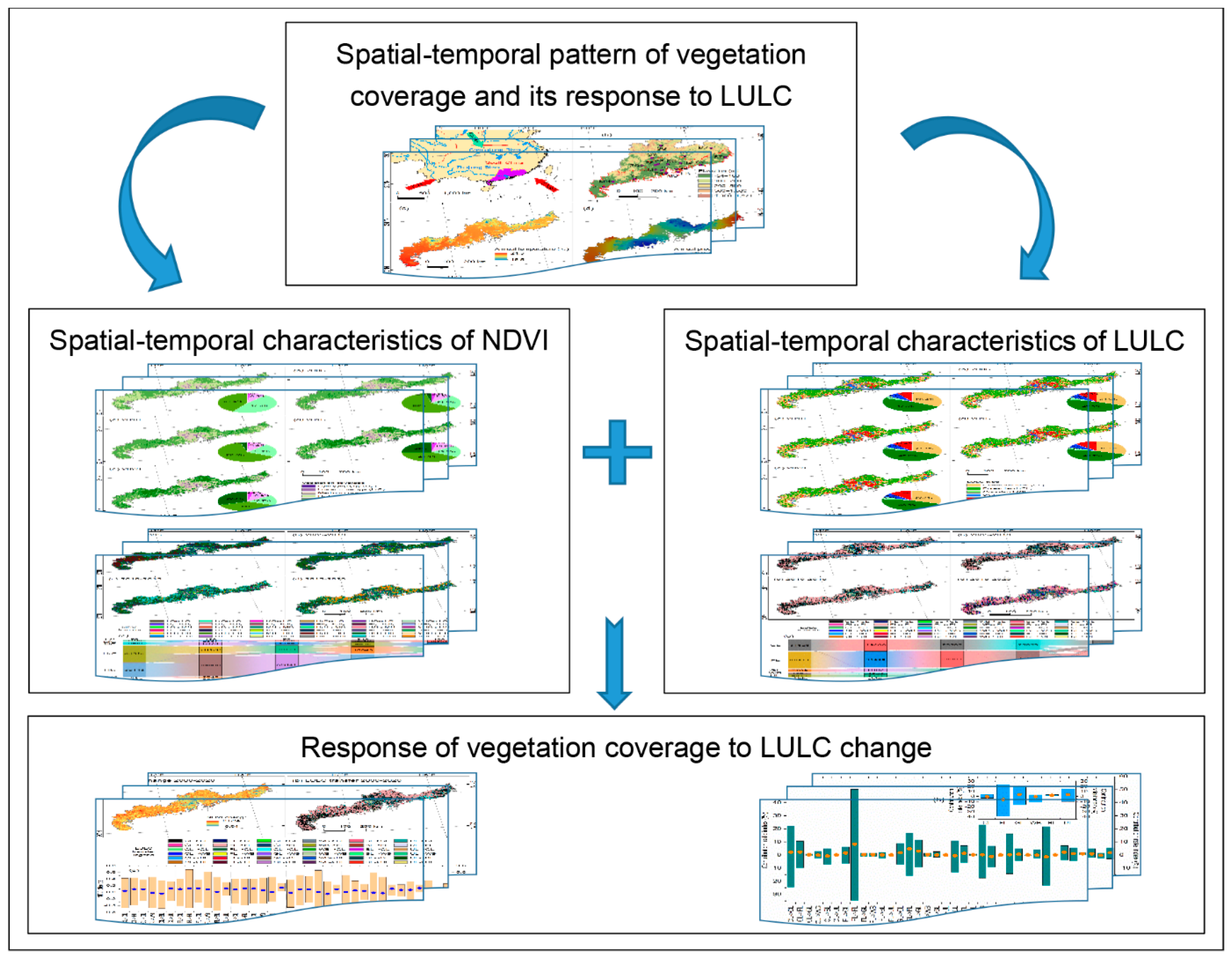
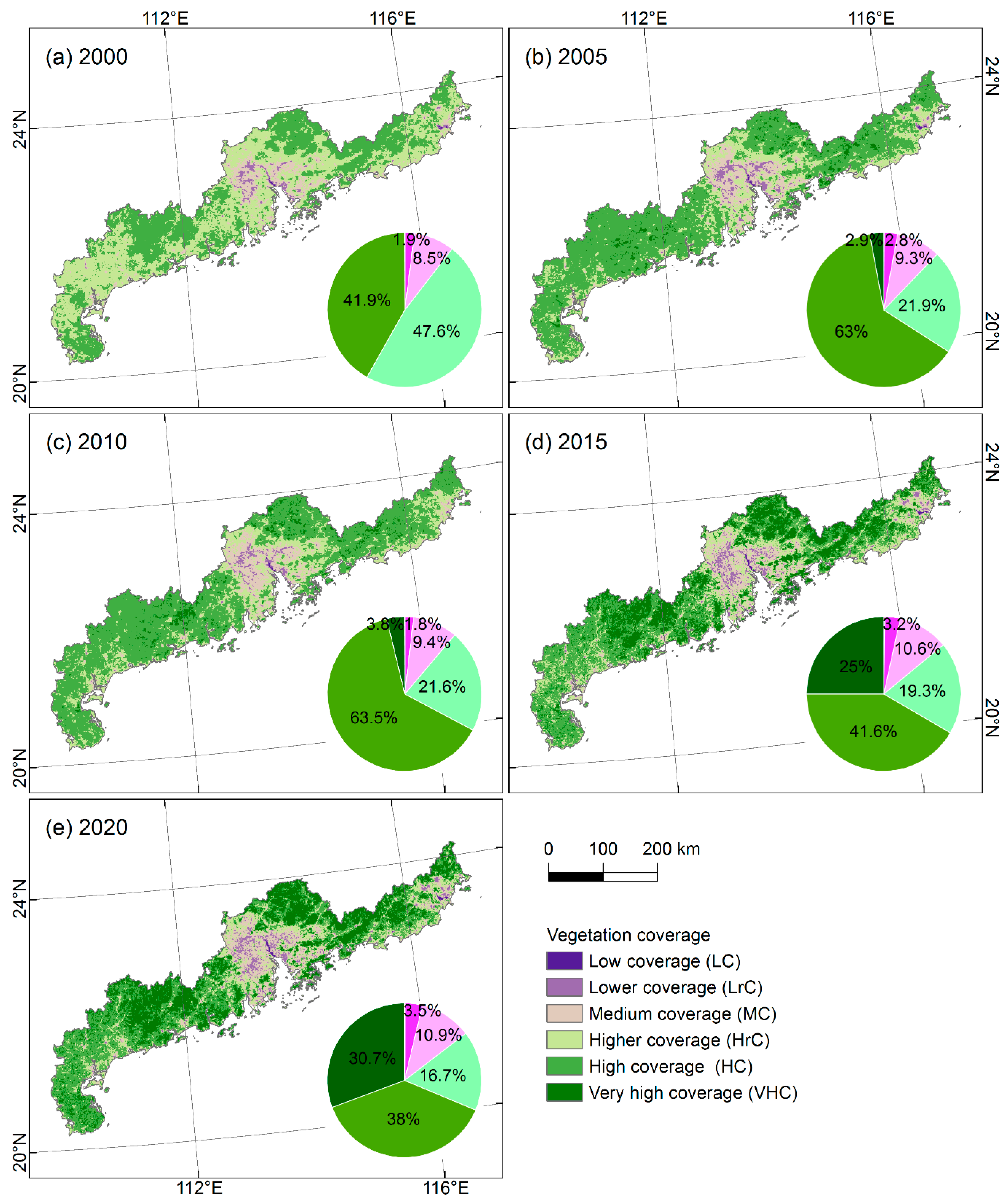
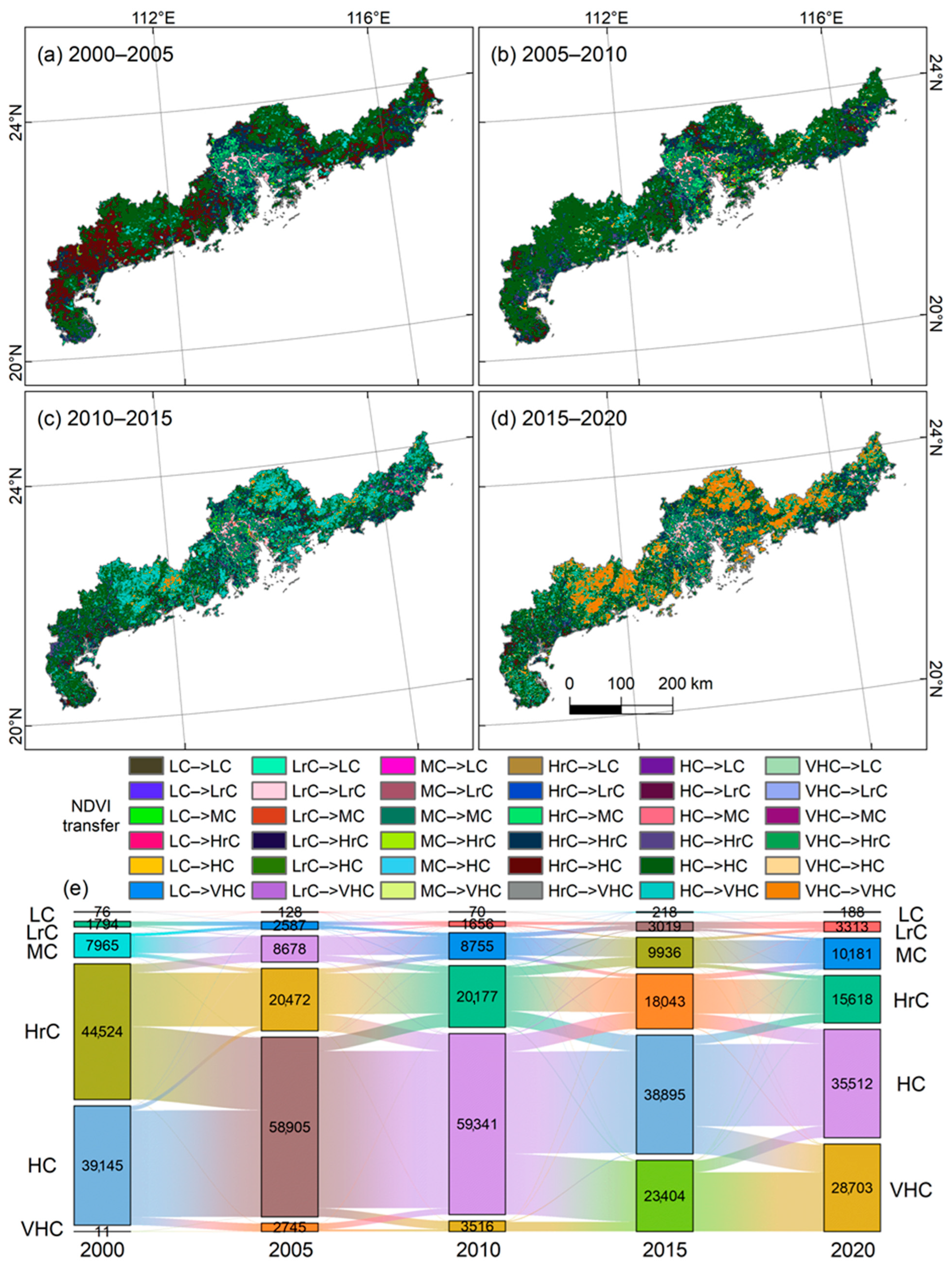
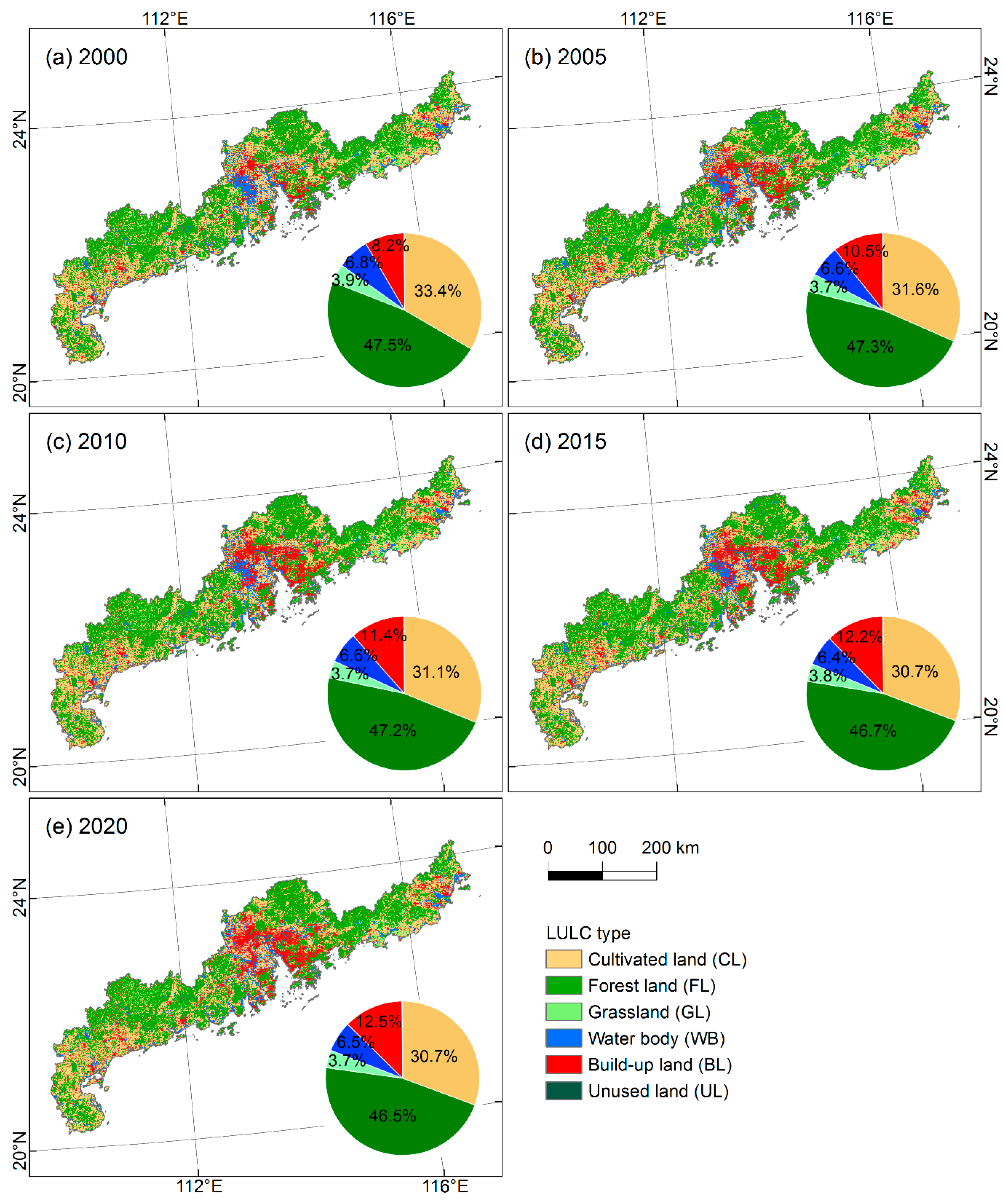

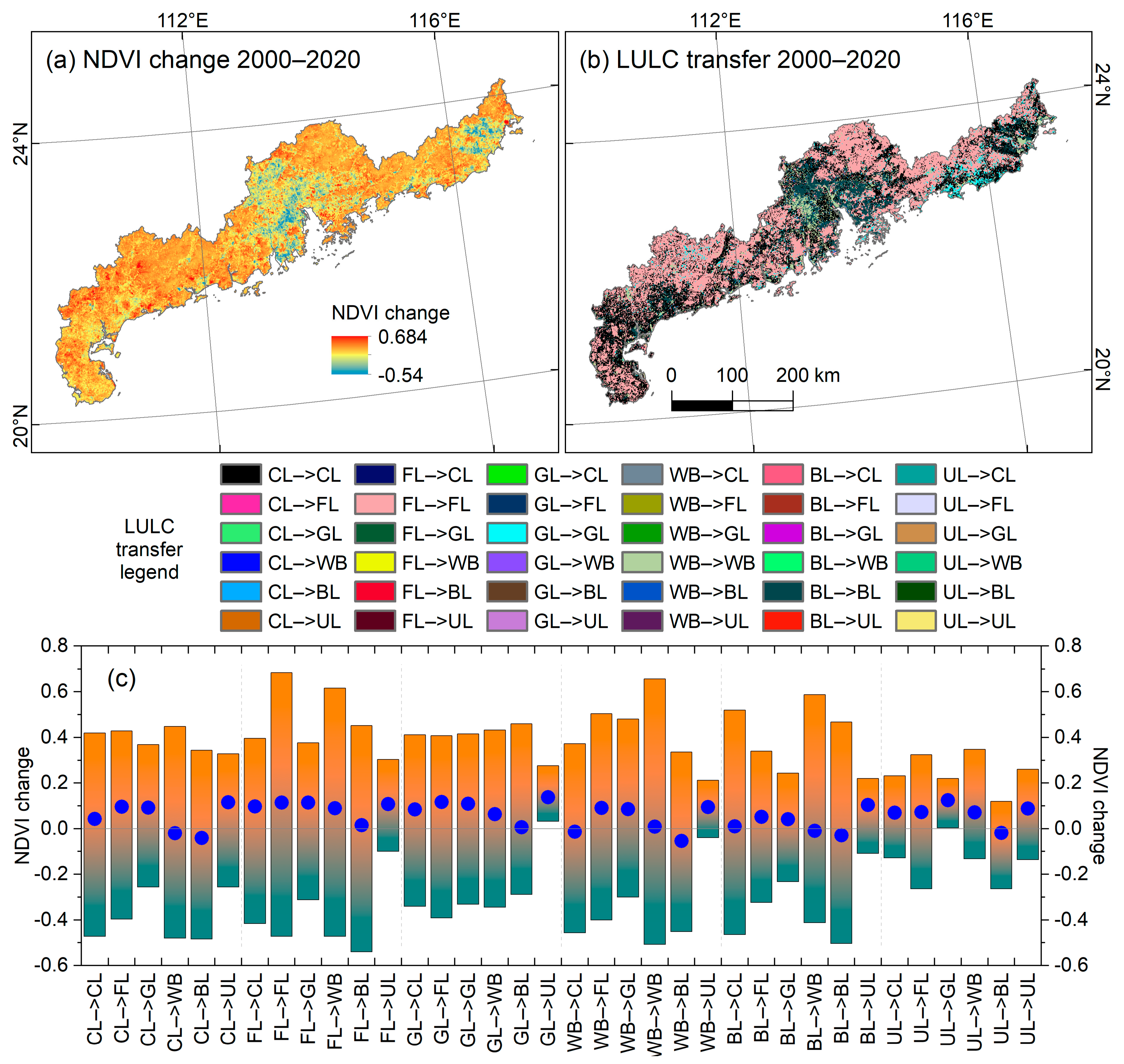
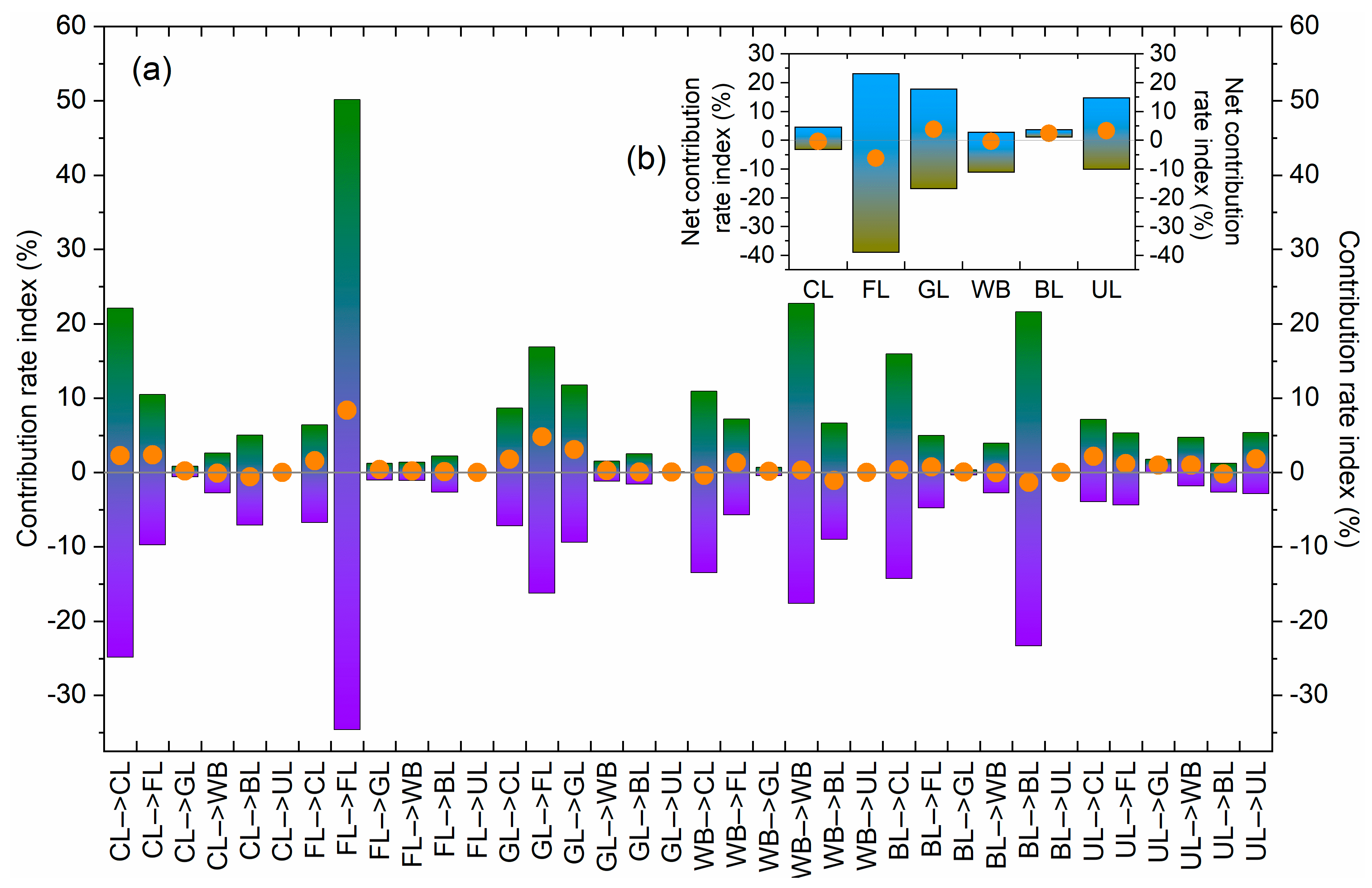
| 2000–2005 | 2005–2010 | 2010–2015 | 2015–2020 | 2000–2020 | ||
|---|---|---|---|---|---|---|
| NDVI | LC | 15 | −10 | 45.714 | −2.609 | 7.5 |
| levels | LrC | 8.854 | −7.22 | 16.497 | 1.92 | 4.219 |
| MC | 1.784 | 0.172 | 2.714 | 0.489 | 1.391 | |
| HrC | −10.804 | −0.283 | −2.122 | −2.685 | −3.246 | |
| HC | 10.096 | 0.149 | −6.893 | −1.736 | −0.463 | |
| VHC | 5840 | 5.666 | 113.138 | 4.523 | 15340 | |
| CD | 34.486 | 63.536 | 27.113 | 22.111 | 67.936 | |
| 2000–2005 | 2005–2010 | 2010–2015 | 2015–2020 | 2000–2020 | ||
|---|---|---|---|---|---|---|
| LULC | CL | −1.06 | −0.329 | −0.231 | −0.046 | −0.407 |
| types | FL | −0.105 | −0.055 | −0.178 | −0.09 | −0.106 |
| GL | −0.773 | −0.322 | 0.599 | −0.635 | −0.284 | |
| WB | −0.412 | −0.271 | −0.457 | 0.187 | −0.236 | |
| BL | 5.638 | 1.536 | 1.426 | 0.592 | 2.612 | |
| UL | −1.25 | 0 | 0 | −1.333 | −0.625 | |
| CD | 2.614 | 0.979 | 0.904 | 97.887 | 106.306 | |
Disclaimer/Publisher’s Note: The statements, opinions and data contained in all publications are solely those of the individual author(s) and contributor(s) and not of MDPI and/or the editor(s). MDPI and/or the editor(s) disclaim responsibility for any injury to people or property resulting from any ideas, methods, instructions or products referred to in the content. |
© 2024 by the authors. Licensee MDPI, Basel, Switzerland. This article is an open access article distributed under the terms and conditions of the Creative Commons Attribution (CC BY) license (https://creativecommons.org/licenses/by/4.0/).
Share and Cite
Chen, Z.; Xu, S. Spatiotemporal Pattern of Vegetation Coverage and Its Response to LULC Changes in Coastal Regions in South China from 2000 to 2020. Appl. Sci. 2024, 14, 10694. https://doi.org/10.3390/app142210694
Chen Z, Xu S. Spatiotemporal Pattern of Vegetation Coverage and Its Response to LULC Changes in Coastal Regions in South China from 2000 to 2020. Applied Sciences. 2024; 14(22):10694. https://doi.org/10.3390/app142210694
Chicago/Turabian StyleChen, Zexuan, and Songjun Xu. 2024. "Spatiotemporal Pattern of Vegetation Coverage and Its Response to LULC Changes in Coastal Regions in South China from 2000 to 2020" Applied Sciences 14, no. 22: 10694. https://doi.org/10.3390/app142210694
APA StyleChen, Z., & Xu, S. (2024). Spatiotemporal Pattern of Vegetation Coverage and Its Response to LULC Changes in Coastal Regions in South China from 2000 to 2020. Applied Sciences, 14(22), 10694. https://doi.org/10.3390/app142210694





